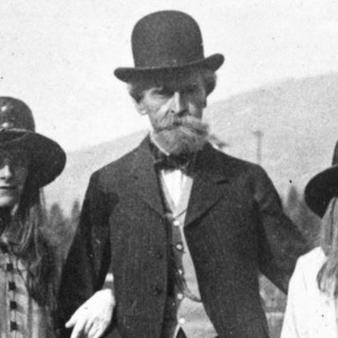Huguette Clark was a mysterious multi-millionaire heiress who lived a life of recluse so hidden from the public eye that not much is known about her. When she died in May 2011, just a few weeks shy of her 105th birthday, she not only left behind a $300 million dollar fortune but also an absolutely stunning collection of jewels, art, antiques, rare instruments and… well, a hell of a lot of valuable stuff for her relatives to fight over. When all was said and done, Huguette Clark's jewelry collection alone fetched $18.3 million at auction. The jewels had been recovered from the bank vault of the reclusive heiress, who lived the last 20 years of her life in Manhattan hospitals and who had rarely been seen since the 1930s.
To recap, Huguette Clark was the last surviving child of copper baron and U.S. Senator William Andrews Clark who made his fortune in mining, railroads, and a host of other ventures. The man had the Midas touch. Whatever business venture he undertook – and there were many – he made ridiculous amounts of money. Huguette, in her later years as well as after her death, was the subject of much curiosity. Not only did she live the last 20 years of her life in hospital rooms despite being relatively healthy, she also had vacant mansions—some never inhabited—scattered across the country.
Huguette was born in Paris in June 1906 and died in May 2011 – the world changed a lot during her lifetime. She was briefly married in her 20s and had no children, surviving siblings, nieces, or nephews. She was alone. She outlived everyone. And let's face it, maintaining three empty mansions, living in a hospital for 22 years, and giving millions of dollars to friends all require a substantial bank account. A few items were put up for sale before her death–such as a Renoir for $23 million, her Connecticut country house and a Stradivarius violin, which we will talk about a bit later.
After Huguette's death a legal battle ensured with relatives, friends, and caregivers fighting over her will. There were two wills and part of the battle was over the changes made between the first and second wills, as well as the vast fortune involved. Last year a settlement was finally reached to divvy up Ms. Clark's estate, estimated to be worth $300 million.
The Jewelry and Art Deco Era Collectibles
- The highlight of Huguette's jewelry collection was a rare 9-carat purplish-pink diamond ring, with a pre-sale estimate of $6 million to $8 million. It sold for $14 million.
- The first two items auctioned off were a pair of onyx photo frames that were estimated to be worth $6,000. Each frame sold for $60,000.
- Two art deco bracelets sold for $90,000 and $480,000.
The total for the Clark items auctioned off in this lot by Christie's was $20.8 million. The items were in impeccable condition, especially the jewelry, which were all in the original boxes in a bank vault, where they had been stored since the 1940s.
The Art
- On May 5th, one of Claude Monet's water lilies paintings that belonged to Huguette sold for $27 million. The 1907 painting, called "Nympheas" was sold to an unidentified private buyer in Asia.
The following works of art will be offered for auction on June 18, 2014
- Renoir's "Jeunes filles jouant au Volant" Estimate: $10 – 15 million
- Renoir's "Chrysanthèmes" Estimate: $3.5-5.5 million
- Renoir's "Femme à l'ombrelle" Estimate: $3-5 million
- John Singer Sargent's "Girl Fishing at San Vigilio" Estimate: $3-5 million
- William Merritt Chase's "A Water Fountain in Prospect Park" Estimate: $700,000 – $1 million
The Stradivarius Violins
Huguette Clark also owned a rare and valuable Stradivarius violin that her father W.A. Clark bought for her to play when she was a teenager. The violin was crafted in 1731, and known as the Kreutzer after the famous French musician who Beethoven composed Violin Sonata No 9 for and who was the instrument's former owner. The violin was found in a cabinet in one of Huguette's vacant mansions. It sold for $7 million.
This violin was just one of several Stradivarius violins she owned in her lifetime. There are 650 of these violins in existence today and nine can be traced to the Clark family, including four that are known as the Paganini quartet. Huguette collected these rare violins and donated to Washington D.C.'s Corcoran Gallery of Art. The Corcoran sold them in 1994 for $15 million to the Nippon Foundation in Japan.
La Pucelle, also known as The Virgin is a 1709 Stradivarius violin. This violin was given to Huguette Clark by her mother on the 50th birthday in June 1956. It was given its name in the mid-19th century by a Parisian dealer who was performing maintenance on the instrument and observed that the violin had remained untouched since it left Stradivari's workshop. It led him to exclaim "C'est comme une pucelle!" (It's like a virgin!" The name stuck. It is considered the very first example of the instruments forming Stradivari's "Golden Period". Huguette sold the violin to collector David L. Fulton in 2001 under a contract that concealed the identity of the seller and the amount it sold for (reportedly $6 million) for 10 years. Fulton software millionaire in the Seattle area who merged his Fox Software database company into Microsoft, using his fortune to collect the world's finest violins.
The Mansions
And then there is the real estate. Huguette Clark owned three apartments in a tony building on New York's Fifth Avenue, a New Canaan, Connecticut estate, known as Le Beau Chateau which Huguette never inhabited, and her Santa Barbara, California mansion known as Bellosuardo.
- Apartment #1 sold for $25.5 million
- Apartment #2 sold for $22.5 million
- Apartment # 3 sold for $6.8 million
- Le Beau Chateau sold to fashion designer Reed Krakoff and his wife for $14.3 million
- Bellosuardo has an estimated value of $100 million is not on the market as the second will of Huguette Clark designates it as a public museum and home for her art collection. The estate has been frozen in time since the 1950s and maintained as if its owner would show up at any moment. This cost $40,000 per month.
Her Doll Collection
Huguette Clark's extensive and intricate collection of dolls, estimated to be worth $4 million, is not for sale. The second will left them to her nurse.
The Cash
The bulk of Huguette Clark's $300 million fortune was donated to charity. She also left money for her longtime nurse, her attorney, several employees, and her goddaughter. She did not leave anything to her family. She clearly stated that nothing was to be left to her relatives, who were not in any way a part of her life. Many had not even see Ms. Clark since 1957. The relatives contested her will and a complicated legal battle ensured. It has been settled thusly:
- Despite her wishes, Huguette's 20 relatives get $34.5 million to spilt up amongst themselves.
- The settlement provides for an arts foundation as Huguette wished. This foundation encompasses the Santa Barbara mansion.
- Clark's longtime nurse and companion Hadassah Peri, who had been given $31 million in gifts while Clark was alive and was set to receive $30 million more in the will has been left out of the settlement. In fact, she has been mandated to return $5 million from the amount of gifts she received. The attorney general's office determined that "the gifts to a caregiver were excessive and presumed to be the product of undue influence."
- Huguette's accountant and attorney were stripped of their executors of her estate roles, which would have given each of them $3 million. In the settlement, they get nothing.





















